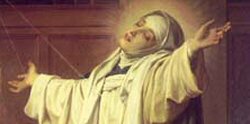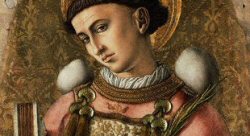Special thanks to a reader who let me know about this article from 2003 in the Archdiocese of Kansas paper The LeavenFaith of our Fathers: He's ancient of days. He can't see very well. And he has been known to be slow to change. But at age 93 Msgr. Heliodore Mejak has no intention of calling it quits.
By Bethanne Scholl
Special to the
Leaven
The joke goes something like this: Old priests don't retire, they just . . .
Having trouble filling in the blank?
Maybe it's because there is no punch line.
Out of a lifelong love of their priestly vocation and a concern for their parishes, many old priests just don't want to retire.
It is probably safe to say that Msgr. Heliodore Mejak, who will turn 94 on St. Patrick's Day, is one of the oldest active priests in the country, perhaps even in the world.
He is by far the oldest active priest in the archdiocese, celebrating Masses seven days a week for the 200 or so families of his Kansas City, Kan., parish of Holy Family.
At 93 and counting, Msgr. Mejak could be said to be stubborn, firmly set in his ways. He is a little shy and has been described as "not exactly gruff."
He does not mince words, but speaks his mind - a sharp, intelligent and driven man. He shepherds his flock with the love of a strict parent.
Holy Family is one of the few remaining "national" parishes in the archdiocese - that is, a parish founded, usually in the early 20th century, to meet the spiritual needs of a particular immigrant group. Holy Family was founded in 1907 to serve the influx of Slovenian immigrants to the Strawberry Hill area.
"They wanted another Slovenian priest to take over," said Msgr. Mejak, of his assignment to the parish. "So the bishop sent me here 68 years ago."
"I can understand Slovenian, but I can't talk a word of it," he said. "My mother was Bohemian; my father, Slovenian. But the official language in Yugoslavia at the time was German, so we spoke German in the house."
"I still hear Slovenian and Croatian confessions," said Msgr. Mejak, "but no more German. They're all gone now."
Msgr. Mejak's father died when he was nine, leaving him as the head of the house. He took on his new role willingly, using his quick mind and capable hands to help his seamstress mother take care of his two younger sisters.
"I've always been very handy," said Msgr. Mejak. "I remember wiring our house when I was 16 years old. I could figure out everything. I was the first one to build my own radio when they came out. I had the best one in town."
Msgr. Mejak's pride and joy are the five brass model trains he has built over the past 40 years. Each part was painstakingly handcrafted with steady hands and a keen eye.
"I loved working with my hands," he said.
But about 10 years ago, Msgr. Mejak was diagnosed with a degenerative eye disease, leaving him legally blind. He no longer works with his hands or drives a car. And he has never been able to master the latest technological advances of a computer - he simply can't see the screen.
"Father has always been self-sufficient," said a parishioner. "He has never asked for help. I can't remember if he ever did. He never wanted a secretary or a live-in housekeeper.
"If he ever got a tear in his clothes, he'd just get out his Singer sewing machine and fix it," she said. "See, he learned that from his mother. When she was sewing and cooking, Father was right there, learning it too."
"Slovenians are a very determined people," she added simply.
That character trait served Msgr. Mejak well when the deterioration of his eyesight made it harder and harder for him to celebrate Mass.
"He enlarges the readings," said one parishioner, "by wearing large (magnifying) goggles over his glasses. He just has to read slowly [relying primarily on his peripheral vision].
"Sometimes he loses his place and he has to refocus. Then we go on. He is very dedicated and very determined and doesn't want to give up."
"We take it day by day together," she said.
"I memorize the prayer and the Gospel the day before," said Msgr. Mejak. "The Gospel is no problem after all these years, but sometimes the prayers are difficult."
"I can't see the headlines in the newspaper. They're too big, and I can only see a part of those letters," he said. "I magnify everything only about a quarter of an inch.
"I work that Xerox machine to death."
Msgr. Mejak still types the weekly bulletin, despite his failing sight.
"He has always been an excellent typist," said a parishioner. "He does make errors. He'll say, 'Was it very bad?' And we'll tell him, 'No, Father, it wasn't that bad.' He wants to do it."
While lay lectors have been a part of most parishes since the Second Vatican Council changes were implemented in the '70s, it has only been in the last four or five years that Holy Family has seen them.
"We don't have the sign of peace, no eucharistic ministers. I call it a 'chapel' type of service," said a parishioner. "Father started letting the children from the school read a few years ago, and after a while we were quite sure Father was OK about lectors. It was time for him to say 'yes.'
"When he absolutely cannot do it anymore, he'll say 'yes.'"
Holy Family still has a Communion rail that is used daily as well as tabernacle veils - vestiges of a church many Catholics today have never even seen.
"Father takes care of ordering the candles and the missalettes," said a parishioner. "He sets up the vestments and takes care of the tabernacle veils. We have things at Holy Family that you'll never see in any other church anymore. But we've never heard a complaint, ever."
Msgr. Mejak makes no apologies for the way his parish is run.
"I am old and traditional," he said. "I believe in old-fashioned things. I must do something that attracts people here. People come here from six other counties that don't really belong here. People go where they feel comfortable. A lot of people feel at home here. We're down to earth, not snooty."
When asked about retirement, Msgr. Mejak is matter of fact.
"If I got sick and I had to retire, I think I'd die in six months - out of boredom," he said. "At the end of seminary, I was told I'd never be a preacher. That's true. I'm a lousy preacher, but I'm a good lover, so to speak. I love the people here in the parish, and I think they love me. That makes up for a lot of it."
"Because of the shortage of priests, they're not going to send another priest here," said Msgr. Mejak. "Maybe they'd combine this parish with another or just close it down. I've baptized and married three generations here."
"We all talk about [his retirement] and think about it," said a parishioner. "But Father doesn't make any definite comments. He isn't interested in retiring. He wouldn't have anything to do."
"I don't know what I could do if I retired," said Msgr. Mejak. "I've never taken a vacation in 25 years. All my buddies died, you see.
"I still have friends. A group of us priests get together at Bishop Forst's and play cards and have dinner - talking the bull. They demand that I make chili for them."
"I still have friends," he added, "but not buddies."
"I was ordained to serve the people," said Msgr. Mejak, "and I can do it. That's a beautiful thing."
"I'm very happy here," he concluded. "We're out of debt. We have money in the bank. I love this parish."









.jpg)
















.jpg)
.jpg)



























